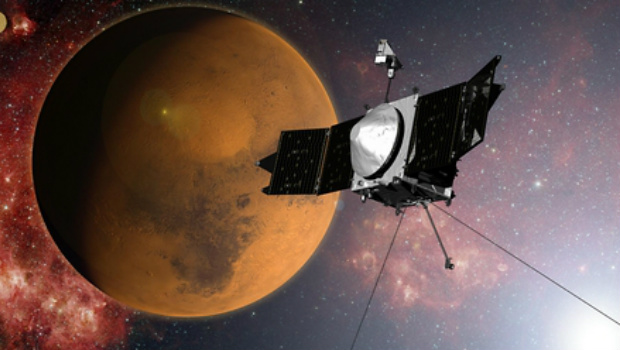NASA’s Mars Atmosphere and Volatile Evolution, or MAVEN, spacecraft is less than two weeks away from wrapping up a 10-month journey to Mars’ orbit, from where it will study the planet’s atmosphere and shed more light on its history.
The craft was launched by NASA from Cape Canaveral last November. It’s set to to enter Mars’ orbit, on 21 September. The interplanetary journey took MAVEN over 442 million miles.
“We’re the first mission devoted to observing the upper atmosphere of Mars and how it interacts with the sun and the solar wind,” said Bruce Jakosky, principal investigator for MAVEN at the University of Colorado in Boulder.
MAVEN is loaded with scientific instruments designed to help scientists find out what happened to the planet’s atmosphere and the water that flowed there long ago. With each orbit, the instruments will measure the composition, structure and escape of atmospheric gases.
“MAVEN’s orbit through the tenuous top of the atmosphere will be unique among Mars missions,” said Jakosky. “We’ll get a new perspective on the planet and the history of the Martian climate, liquid water and planetary habitability by microbes.”
Scientists hope that Maven can provide another piece of the puzzle that is the history of Mars. For years now, researchers have been trying to figure out if Mars was ever had water flowing on its surface, if it was able to support life and what happened to its atmosphere.
To explore Mars, NASA has other orbiters and has had three robotic rovers, including the super rover Curiosity, and Opportunity, which has been working on Mars for more than 10 years. The robots have been searching for clues to Mars’ history on the surface and have found evidence of ancient water flows.
MAVEN, NASA’s first spacecraft with a single goal of studying the Martian atmosphere, will set its sights on scientific research above the planet. How much gas from Mars’ atmosphere has been lost to space throughout the planet’s history? What drove that loss?
NASA engineers will be uploading software updates – over millions of miles – to provide information needed by the craft to manage its location, velocity and orientation so it can insert itself, without human intervention, into Mars orbit. The entire insertion will be guided by MAVEN’s onboard computers.
If, however, engineers on the ground determine that the spacecraft is headed toward the insertion point at too low of an altitude, ground control could step in and correct its course.
Otherwise, the spacecraft’s computers will be in full control of its maneuvers.
Computerworld







Subscribers 0
Fans 0
Followers 0
Followers